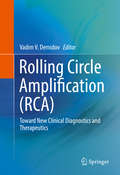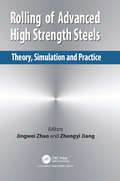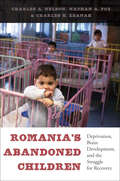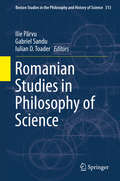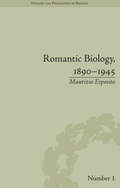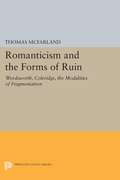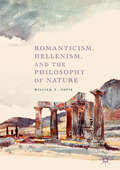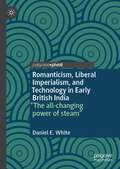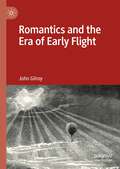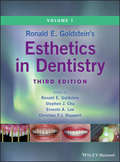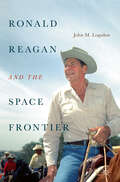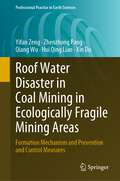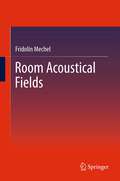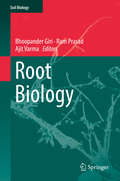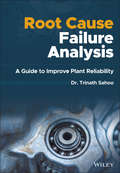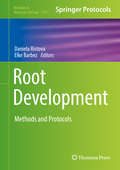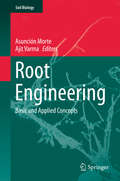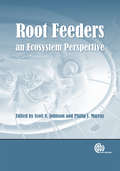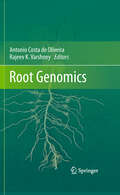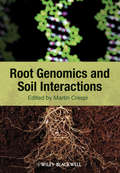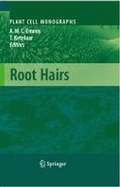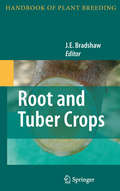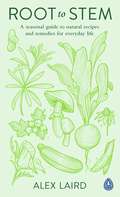- Table View
- List View
Rolling Circle Amplification (RCA)
by Vadim V. DemidovThis book covers the latest developments in rolling circle amplification (RCA) technology with applications in clinical diagnostic tests and molecular medicine. Topics covered include new enzymes useful in RCA, techniques involving RCA for enhanced signal amplification, novel RCA diagnostics, sensors for expediting RCA detection, and prospective RCA-based therapeutics. This is a valuable book for university professors and students in the field of biomedical engineering and biomolecular pharmacology as well as R&D managers of biotechnology and biopharmaceutical companies. Specifically, this book: Reviews prospective RCA-based therapeutics, including RCA-derived DNA nanoparticles that strongly bind to cancer cells Expands readers' understanding of sensor systems for expediting detection of RCA products by using probe-tagged magnetic nanobeads Maximizes reader insights into novel RCA diagnostics, such as PNA openers-assisted RCA for detection of single target cells and in situ RCA diagnosis of cancer cells and malignant tissues Presents innovative methods for quasi-exponential enhancement of RCA-generated signals, such as nicking enzyme-assisted cascade RCA and RCA coupled with loop-mediated amplification
Rolling of Advanced High Strength Steels: Theory, Simulation and Practice
by Jingwei Zhao Zhengyi JiangAdvanced high strength steels (AHSSs) for auto-making are primarily produced by rolling, plus heat treatment technologies if necessary. However, due to the metallurgical complexity of AHSSs, it is impossible to roll all of the AHSS grades in a rolling mill with the same rolling technology. Each of AHSSs has unique applications in vehicles, and specified rolling technologies are required to produce high quality AHSS products where they might be the best employed to meet performance demands of the automotive parts. Such background has prompted the publication of this scholarly book in the area of rolling of AHSSs with a purpose of providing readers with a valuable technical document that can be used in the research and development of AHSSs for automotive and other manufacturing industries. With contributors from USA, Germany, Poland, Italy, Spain, Austria, Australia, China, India and Iran, the book highlights the latest advances in rolling technologies of AHSSs. It focuses on the theory, simulation and practice of the rolling of AHSSs: The book introduces the history, types and advances of AHSSs and their processes; proposes new theory that is applicable to the rolling of AHSSs, presents mathematical and numerical modelling of AHSSs in rolling; covers thermomechanical processing technologies of AHSSs; provides case studies on the rolling practice of the most popular AHSSs and includes other rolling-related technologies of AHSSs. The book will be useful for both theoretical and applied research aimed at AHSSs rolling technologies, and will be a scientific and valuable literature for the metallurgists, engineers, materials scientists, academics and graduate students who are studying and working with AHSSs and their rolling technologies worldwide.
Romancing the Birds and Dinosaurs: Forays in Postmodern Paleontology
by Alan FeducciaBirds and dinosaurs have dominated human interest for decades. In this well-supported revolutionary view of the field, critical questions are explored with credible evidence and biological thought. Are birds derived directly from advanced dinosaurs, or ar
Romania's Abandoned Children: Deprivation, Brain Development, and the Struggle for Recovery
by Charles A. Nelson Nathan A. Fox Charles H. ZeanahThis &“landmark study of child development&” examines the devastating effects of early childhood institutionalization (Avshalom Caspi, Duke University). In 1989, the fall of Romania's Ceausescu regime left approximately 170,000 children in impoverished institutions across the country. This crisis prompted the most comprehensive study to date on the effects of institutionalization on a child&’s brain development, behavior, and psychological functioning. Romania's Abandoned Children documents this landmark study, and the devastating toll paid by children who are deprived of responsive care, social interaction, stimulation, and psychological comfort. Launched in 2000, the Bucharest Early Intervention Project was a rigorously controlled investigation of foster care as an alternative to institutionalization. Examining a total of 136 abandoned infants and toddlers, researchers randomly assigned half of them to foster care, while the other half stayed in Romanian institutions. Over a twelve-year span, both groups were assessed for physical growth, cognitive functioning, brain development, and social behavior. Data from a third group of children raised by their birth families were collected for comparison. The study found that the institutionalized children were severely impaired, but that the sooner they were placed into foster care, the better their recovery. Combining scientific, historical, and personal narratives in a gripping, often heartbreaking, account, Romania's Abandoned Children highlights the need to help the millions of parentless children living in institutions throughout the world.
Romanian Studies in Philosophy of Science
by Gabriel Sandu Ilie Pȃrvu Iulian D. ToaderThis book presents a collection of studies by Romanian philosophers, addressing foundational issues currently debated in contemporary philosophy of science. It offers a historical survey of the tradition of scientific philosophy in Romania. It examines some problems in the foundations of logic, mathematics, linguistics, the natural and social sciences. Among the more specific topics, it discusses scientific explanation, models, and mechanisms, as well as memory, artifacts, and rules of research. The book is useful to those interested in the philosophy of real science, but also to those interested in Romanian philosophy.
Romantic Biology, 1890–1945 (History and Philosophy of Biology #1)
by Maurizio EspositoIn this book, Esposito presents a historiography of organicist and holistic thought through an examination of the work of leading biologists from Britain and America. He shows how this work relates to earlier Romantic tradition and sets it within the wider context of the history and philosophy of the life sciences.
Romanticism and the Forms of Ruin: Wordsworth, Coleridge, and the Modalities of Fragmentation
by Thomas McfarlandDespite their hopeful aspirations to wholeness in life and spirit, Thomas McFarland contends, the Romantics were ruins amidst ruins," fragments of human existence in a disintegrating world. Focusing on Wordsworth and Coleridge, Professor McFarland shows how this was true not only for each of these Romantics in particular but also for Romanticism in general. Originally published in 1981.
Romanticism, Hellenism, and the Philosophy of Nature
by William S. DavisThis book investigates intersections between the philosophy of nature and Hellenism in British and German Romanticism, focusing primarily on five central literary/philosophical figures: Friedrich Schelling, Friedrich Hölderlin, Johann Wolfgang von Goethe, Percy Shelley, and Lord Byron. Near the end of the eighteenth century, poets and thinkers reinvented Greece as a site of aesthetic and ontological wholeness, a move that corresponded with a refiguring of nature as a dynamically interconnected web in which each part is linked to the living whole. This vision of a vibrant materiality that allows us to become “one with all that lives,” along with a Romantic version of Hellenism that wished to reassemble the broken fragments of an imaginary Greece as both site and symbol of this all-unity, functioned as a two-pronged response to subjective anxiety that arose in the wake of Kant and Fichte. The result is a form of resistance to an idealism that appeared to leave little room for a world of beauty, love, and nature beyond the self.
Romanticism, Liberal Imperialism, and Technology in Early British India: “The all-changing power of steam”
by Daniel E. WhiteConsidering metropolitan and colonial cultural production as a “unitary field of analysis,” this book shows how tensions in the 1830s between utilitarian and Romantic perspectives on steam power marked meaningful divisions within the pervasive liberal imperialism of the period and generated divergent speculative fantasies, set in the twentieth and twenty-first centuries, about the future of Indian nationalism. Poetry and fiction in Britain and Bengal engage with a Romantic strain of thought and sentiment according to which steam technology represents an anti-utilitarian humanization of nature. Within and against that frame and in uneven and different ways, writers in British India map a constellation of liberal values onto their hopes and fears concerning a future powered by steam.
Romantics and the Era of Early Flight
by John GilroyThis book explores the significance of flight to Romantic literature. Although the Romantic movement and the age of ballooning coincided, there has been a curious and long-time tendency to forget that flight was not impossible during this period. This study details the importance of this new technology to Romantic authors, primarily English Romantic poets. It combines accounts of the exploits and experiences of early balloonists with references to Romantic texts, using ballooning lore to illuminate a range of Romantic writings. The balloonists are seen as not just supplying these writers with a new code of metaphors, but as colleagues engaged in similarly imaginative enterprises. The book uncovers an ‘aerial imagination’ shared by a large number of writers in the Romantic period that has its origins in the balloon adventures of the 1780s and following two decades. It will appeal to scholars and students of Romantic cultural history, as well as those interested in Romantic poetry and the history of early aeronautics.
Ronald E. Goldstein's Esthetics in Dentistry
by Ronald E. Goldstein Stephen J. Chu Ernesto A. Lee Christian F.J. StappertRonald E. Goldstein’s Esthetics in Dentistry, Third Edition provides a thoroughly updated and expanded revision to the definitive reference to all aspects of esthetic and cosmetic dentistry, from principles and treatments to specific challenges and complications. Provides a current, comprehensive examination of all aspects of esthetic and cosmetic dentistry Presents 23 new chapters from international experts in the field and complete updates to existing chapters Offers more than 3,700 high-quality photographs and illustrations Adds clinical case studies and treatment algorithms for increased clinical relevance Emphasizes clinical relevance, with all information thoroughly rooted in the scientific evidence
Ronald Reagan and the Space Frontier (Palgrave Studies in the History of Science and Technology)
by John M. LogsdonWhen Ronald Reagan was elected in 1980, limits on NASA funding and the lack of direction under the Nixon and Carter administrations had left the U.S. space program at a crossroads. In contrast to his predecessors, Reagan saw outer space as humanity’s final frontier and as an opportunity for global leadership. His optimism and belief in American exceptionalism guided a decade of U.S. activities in space, including bringing the space shuttle into operation, dealing with the 1986 Challenger accident and its aftermath, committing to a permanently crewed space station, encouraging private sector space efforts, and fostering international space partnerships with both U.S. allies and with the Soviet Union. Drawing from a trove of declassified primary source materials and oral history interviews, John M. Logsdon provides the first comprehensive account of Reagan’s civilian and commercial space policies during his eight years in the White House. Even as a fiscal conservative who was hesitant to increase NASA’s budget, Reagan’s enthusiasm for the space program made him perhaps the most pro-space president in American history.
Roof Water Disaster in Coal Mining in Ecologically Fragile Mining Areas: Formation Mechanism and Prevention and Control Measures (Professional Practice in Earth Sciences)
by Yifan Zeng Zhenzhong Pang Qiang Wu Hui Qing Lian Xin DuThis book targets to earth scientists and engineers, in particular students, researchers, managers, and practitioners, who are interested in mining engineering, environmental engineering, green coal mining, sustainable water resource management, and effective measures to balance mine safety and ecological conservation. In the disciplines of mine hydrogeology and mining engineering, there have always been difficulties in the theoretical interpretation of the changes in the physical and hydraulic characteristics of water resisting strata during coal seam mining. In the past 10 years, the authors studied the relevant contents by using the methods of physical simulation, numerical simulation, field test and mining practice of similar materials, so as to understand the internal relationship between the stratigraphic sedimentary characteristics of the mining area and the occurrence mechanism of mine water disaster. On the premise of analyzing and studying the stratigraphic sedimentary environment in the mining area in detail, it is of great significance for the realization of "coal water" dual resource mining in the mining area to divide the types of roof water disaster in the mining area and study the formation mechanism of mine water disaster caused by different rock formation combinations and mining methods.
Room Acoustical Fields
by Fridolin MechelThis book presents the theory of room acoustical fields and revises the Mirror Source Methods for practical computational use, emphasizing the wave character of acoustical fields. The presented higher methods include the concepts of "Mirror Point Sources" and "Corner sources which allow for an excellent approximation of complex room geometries and even equipped rooms. In contrast to classical description, this book extends the theory of sound fields describing them by their complex sound pressure and the particle velocity. This approach enables accurate descriptions of interference and absorption phenomena.
Room Temperature Photon Detectors
by Antoni Rogalski Weida Hu Piotr MartyniukRoom Temperature Photon Detectors provides an overview of the performance of emerging new generation of room temperature photodetectors generally called low-dimensional solid (LDS) photodetectors among which the most important are two-dimensional (2D) materials, perovskites, and quantum dots (QDs)/nanowires (NWs) operating in a wide spectral range from the ultraviolet (UV), visible (VIS), far infrared (FIR) to terahertz (THz). The LDS reported performance at room temperature is even better than that presented for standard commercial photodetectors.This book describes the peculiarities of the physical properties of LDS materials and their impact on the photodetectors’ performance. It also undertakes a comprehensive analysis of these performances when confronted with the standard photodetectors dominating the global market.Currently, intensive efforts are being made to reduce the cost of imaging systems and, in particular in the infrared (IR) range, to increase their operating temperature by reducing size, weight and power consumption (SWaP). This raises the question of whether the emergence of a new generation of LDS photodetectors will result in their rapid commercialization and serious competition for the standardized bulk photodetectors. This book attempts to answer those issues/questions.Features• Defines the importance of LDS photodetectors in the broad group of standard UV, VIS, IR, and THz photodetectors, and includes their advantages/disadvantages• Covers different types of photodetectors, including the relevant aspects of theory, types of materials, their physical properties, and detector fabrication• Provides invaluable resource for graduate students in physics and engineering, as well as a guide for those already working with sensors and systems, thermal imaging, remote sensing, optical telecommunications, and light detection.
Root Biology: Basic And Applied Concepts (Soil Biology Ser. #52)
by Ajit Varma Ram Prasad Bhoopander GiriThe book ‘Root Biology’ written by experts in the field, covers latest research on cellular, genetic, physiological and ecological developmental facets of root growth as well as the interaction of root with an array of microbes whether for the establishment of symbiosis, increasing plant growth or protecting plant from pathogens/attackers. Plant roots provide an excellent model to study physiological, developmental and metabolic processes at a system level. Root system architecture - an excellent creation of nature, is closely interconnected with the availability of soil nutrients. Several strategies including biotechnological interventions are gaining interest and importance for sustainable food production and enhanced resource acquisition. Such strategies have largely focused on root traits for efficient utilization of soil resources. The biotechnological application of root biology is expected to promote the production of food while maintaining ecologically and economically sustainable production systems.With a fortune of information on technical and experimental aspects useful in the laboratory, this extensive book is a valuable resource for researchers, academician and students in the broad field of microbiology, plant and fungal biology.
Root Cause Failure Analysis: A Guide to Improve Plant Reliability
by Trinath SahooRoot Cause Failure Analysis Provides the knowledge and failure analysis skills necessary for preventing and investigating process equipment failuresProcess equipment and piping systems are essential for plant availability and performance. Regularly exposed to hazardous service conditions and damage mechanisms, these critical plant assets can result in major failures if not effectively monitored and assessed—potentially causing serious injuries and significant business losses. When used proactively, Root Cause Failure Analysis (RCFA) helps reliability engineers inspect the process equipment and piping system before any abnormal conditions occur. RCFA is equally important after a failure happens: it determines the impact of a failure, helps control the resultant damage, and identifies the steps for preventing future problems.Root Cause Failure Analysis: A Guide to Improve Plant Reliability offers readers clear understanding of degradation mechanisms of process equipment and the concepts needed to perform industrial RCFA investigations. This comprehensive resource describes the methodology of RCFA and provides multiple techniques and industry practices for identifying, predicting, and evaluating equipment failures. Divided into two parts, the text first introduces Root Cause Analysis, explains the failure analysis process, and discusses the management of both human and latent error. The second part focuses on failure analysis of various components such as bolted joints, mechanical seals, steam traps, gearboxes, bearings, couplings, pumps, and compressors. This authoritative volume:Illustrates how failures are associated with part integrity, a complete system, or the execution of an engineering processDescribes how proper design, operation, and maintenance of the equipment help to enhance their reliabilityCovers analysis techniques and industry practices including 5-Why RCFA, fault tree analysis, Pareto charts, and Ishikawa diagramsFeatures a detailed case study of process plant machinery and a chapter on proactive measures for avoiding failuresBridging the gap between engineering education and practical application, Root Cause Failure Analysis: A Guide to Improve Plant Reliability is an important reference and guide for industrial professionals, including process plant engineers, planning managers, operation and maintenance engineers, process designers, chemical engineers, and instrument engineers. It is also a valuable text for researchers, instructors, and students in relevant areas of engineering and science.
Root Development: Methods And Protocols (Methods In Molecular Biology #1761)
by Daniela Ristova Elke BarbezThis detailed volume provides diverse elegant methods, complemented with existing protocols, which are optimized for the current needs in plant root biology as well as for use in plant species other than Arabidopsis thaliana. The collection covers methods ranging from genetic screens, phenotypic analysis, and cell biology methods to systems biology tools and genome-wide approaches. The collection contains a range of complexity from fundamental methods for quantification of different root developmental processes to complex methods that require sophisticated equipment. Written for the highly successful Methods in Molecular Biology series, chapters include introductions to their respective topics, lists of the necessary materials and reagents, step-by-step, readily reproducible laboratory protocols, and tips on troubleshooting and avoiding known pitfalls. Authoritative and practical, Root Development: Methods and Protocols serves as a valuable tool for plant biologists specialized in root development, from beginners to experienced researchers in the field.
Root Engineering
by Ajit Varma Asunción MorteThis volume illustrates the complex root system, including the various essential roles of roots as well as their interaction with diverse microorganisms localized in or near the root system. Following initial chapters describing the anatomy and architecture as well as the growth and development of root systems, subsequent chapters focus on the various types of root symbiosis with bacteria and fungi in the rhizosphere. A third section covers the physiological strategies of roots, such as nitrate assimilation, aquaporins, the role of roots in plant defense responses and in response to droughts and salinity changes. The book's final chapters discuss the prospects of applied engineering of roots, i. e. , inventing new root structures or functions through genetic modification, but also with conventional breeding and manipulation of root symbionts. The budding field of root engineering is expected to promote a second green revolution.
Root Feeders: An Ecosystem Perspective
by Scott N. Johnson Philip J. MurrayInteractions between plants and herbivores can have a significant effect on plant growth and development, and ultimately, on a plant's economic value. Research has traditionally focused on above ground herbivores, despite the considerable role that below ground herbivory by both vertebrates and invertebrates can play within a range of ecosystem processes. Root feeders have been classified as agricultural pests but can also be used as biological control agents against invasive species and can affect community dynamics of plants, soil micro-organisms and populations of above ground organisms. Bringing together a broad range of viewpoints and approaches, Root Feeders presents a comprehensive review of knowledge on root herbivores and illustrates their importance within ecosystems. Chapters discuss problems of visualizing the organisms in the soil, their role in agriculture, grassland and forest ecosystems, and present specific case studies on the management, control and influence of root feeders. Covering all aspects from food web ecology to the effects of climate change, this will be valuable reading for researchers and professionals in agricultural entomology, plant science, ecology and soil science.
Root Genomics
by Antonio Costa de Oliveira Rajeev VarshneyWith the predicted increase of the human population and the subsequent need for larger food supplies, root health in crop plants could play a major role in providing sustainable highly productive crops that can cope with global climate changes. While the essentiality of roots and their relation to plant performance is broadly recognized, less is known about their role in plant growth and development. "Root Genomics" examines how various new genomic technologies are rapidly being applied to the study of roots, including high-throughput sequencing and genotyping, TILLING, transcription factor analysis, comparative genomics, gene discovery and transcriptional profiling, post-transcriptional events regulating microRNAs, proteome profiling and the use of molecular markers such as SSRs, DArTs, and SNPs for QTL analyses and the identification of superior genes/alleles. The book also covers topics such as the molecular breeding of crops in problematic soils and the responses of roots to a variety of stresses.
Root Genomics and Soil Interactions
by Martin CrespiFully integrated and comprehensive in its coverage, Root Genomics and Soil Interactions examines the use of genome-based technologies to understand root development and adaptability to biotic and abiotic stresses and changes in the soil environment. Written by an international team of experts in the field, this timely review highlights both model organisms and important agronomic crops. Coverage includes: novel areas unveiled by genomics research basic root biology and genomic approaches applied to analysis of root responses to the soil environment. Each chapter provides a succinct yet thorough review of research.
Root Hairs
by Anne Mie Emons Tijs KetelaarRoot hairs, the tip-growing extensions of root epidermal cells, are a model system for answering many plant cell and developmental biology research questions. This book, written by experts in the field, covers the research up to 2008 on cellular, genetic, electrophysiological and developmental aspects of root hair growth, as well as the interaction of root hairs with rhizobia and mycorrhizae in the establishment of symbiosis. With a wealth of information on technical and experimental aspects useful in the laboratory, this comprehensive book is a valuable resource for researchers and students in the broad field of plant cell and molecular biology.
Root and Tuber Crops
by J. E. BradshawIt is important to include Tuber and Root Crops in the Handbook of Plant Breeding. They include starchy staple crops that are of increasing importance for global food security and relief of poverty, important millennium goals for the United Nations. Indeed, 2008 was the UN International Year of the Potato in recognition of this role of the potato as the world's third most important food crop after wheat and rice. The other major staples are cassava, sweetpotato and yam. Together they occupy about 50 million hectares, with production at 640 million metric tons, of which 70% is in developing countries. In total there are more than 30 species of Root and Tuber Crops grown in the world today. Given the content of other volumes in the series, it makes sense to include sugar and fodder beets; swedes and turnips; and minor root and tuber crops so that the book series is as complete as possible. Like the other volumes in the series, this one will present information on the latest in applied plant breeding using the current advances in the field, from an efficient use of genetic resources to the impact of biotechnology in plant breeding. Seven crop specific chapters are proposed, together with an introduction to this diverse set of plant species. Outstanding scientists for each crop species are proposed as senior authors, who may invite co-authors to contribute part of a chapter. In order to increase the overall acceptance of the volume, balance will be sought with authors from different research groups/countries who will be asked to contribute and collaborate where appropriate. The book should be of interest to researchers in both academic and industrial settings, and in both developed and developing countries, as well as students and teachers of plant breeding. It is currently extremely important to educate and train a new generation of plant breeders given the challenges faced by humankind in producing more food for an expanding global population during a period of environmental (including climate) change.
Root to Stem: A seasonal guide to natural recipes and remedies for everyday life
by Alex Laird'Root to Stem is a seasonal and holistic approach to health that puts plants, herbs and nature at the heart of how we live and eat. It is a new kind of guide that links individual health to our communities and the planet's health to sustain us all.'This perfect companion to the seasons, this book will show you how to take greater control over your own health and well-being, treat everyday ailments, and ensure the sustainability of the planet through discovering how to forage, grow, or shop for plant- and herb-based foods and products. Including: Detox in the spring with sorrel, cleavers and nettles. Harvest summer lime leaf shoots to soothe digestive upsets and feed gut microbes. Bake a Lammas loaf to celebrate the autumnal equinox. Boost your winter immunity with red berries, purple potatoes and rosehips. Root-to-stem eating encourages you to use every edible part of plant, including the leaves, skin, seeds and stalks.Travelling through the four seasons, expert medical herbalist Alex Laird shares the natural ingredients that are available on your doorstep, simple delicious recipes and easy-to-make herbal remedies.
